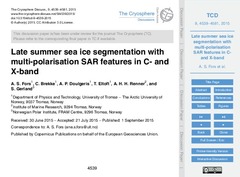Late summer sea ice segmentation with multi-polarisation SAR features in C- and X-band
Permanent link
https://hdl.handle.net/10037/9073Date
2015-09-01Type
Journal articleTidsskriftartikkel
Peer reviewed
Author
Fors, Ane Schwenke; Brekke, Camilla; Doulgeris, Anthony Paul; Eltoft, Torbjørn; Renner, Angelika; Gerland, SebastianAbstract
In this study we investigate the potential of sea ice segmentation by C- and X-band
multi-polarisation synthetic aperture radar (SAR) features during late summer. Five
high-resolution satellite SAR scenes were recorded in the Fram Strait covering iceberg-
fast first-year and old sea ice during a week with air temperatures varying around zero
degrees Celsius. In situ data consisting of sea ice thickness, surface roughness and
aerial photographs were collected during a helicopter flight at the site. Six polarimetric
SAR features were extracted for each of the scenes. The ability of the individual SAR
features to discriminate between sea ice types and their temporally consistency were
examined. All SAR features were found to add value to sea ice type discrimination. Relative
kurtosis, geometric brightness, cross-polarisation ratio and co-polarisation correlation
angle were found to be temporally consistent in the investigated period, while
co-polarisation ratio and co-polarisation correlation magnitude were found to be temporally
inconsistent. An automatic feature-based segmentation algorithm was tested
both for a full SAR feature set, and for a reduced SAR feature set limited to temporally
consistent features. In general, the algorithm produces a good late summer sea ice
segmentation. Excluding temporally inconsistent SAR features improved the segmentation
at air temperatures above zero degrees Celsius.
Description
Published version. Source at http://doi.org/10.5194/tcd-9-4539-2015.


 English
English norsk
norsk